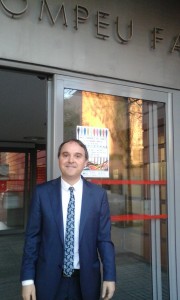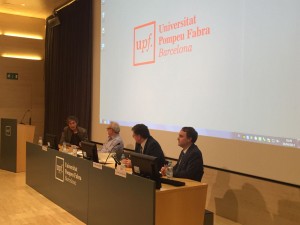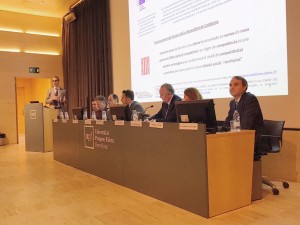Companies demonstrate the need for broadband in industrial estates
The growing need for broadband in industrial estates and the satisfactory overall pace of deployment of fiber optic networks polarized the message of the XXII Catalonia Cable and Broadband Congress, which took place on April 4 and 5 in 22 @ de Barcelona (Auditorium of the Campus of Poblenou of the Universitat Pompeu Fabra) with great success of participation and of contents.

“Companies are aware that the relationship with the end consumer is increasingly digitized, which generates more need for storage and sending of data and, in the end, broadband in every way”, summarizes the Dr. Joan Francesc Fondevila Gascón, director of the Center for Cable Studies (CECABLE), organizer of the event, together with the Department of Communication and the Observatory of Scientific Communication of the University Pompeu Fabra (UPF) and Acotec (Catalan Association of Operators of Cable Telecommunications).
Companies and entities analyzed the strategic factors of telecommunications, such as the evolution of the broadband deployment, the relationship with the consumer and the situation compared to the international framework. In the block on “Broadband in Catalonia and Spain”, Joan Oliver (Wifidom) stressed the need to combine physical cable networks with wireless options, which allow the resolution of difficult access situations to the network.
Broadband and the combination of audiovisual and Internet characterize HbbTV. “The use of the Internet and broadband generates new opportunities,” according to Andrés Román (Sony). Business models adapt to new technologies and content providers can use converged technology options to deliver higher quality content. In parallel, the protection of the rights of the contents allows to maintain the business model. Aligning standards and specifications with service planning is the most effective model of success on HbbTV.
Large operators reflected a healthy state of broadband in Catalonia and Spain. In fact, compared to other countries, the situation is privileged. The rate of deployment of fiber to the home (FTTH) is “high”, to the point that virtually exceeds xDSL connections. José Carlos Mut (Telefónica) underlined the high bandwidth available, in a Gbps dynamic: “Spain has an outstanding infrastructure and connectivity”. Telefónica emphasizes its role as a driver of new generation networks, in the transformation of networks and in the provision of quality customers, since in 2016 the fiber exceeded those of copper. “The medium-term objective of the European Union is in Gbps values, which reflects the need for broadband,” accords to Fondevila.
In that line of guaranteeing access to the network, Xarxa Oberta de Catalunya (XOC), a neutral operator in Catalonia, “tries to optimize the networks that are already deployed”, accords to Carles Viladecans. The operator tries to consolidate the regional network, especially in Solsonès, Bages, Vall d’Aran, Cerdanya, Ripollès, Osona North, La Selva and Priorat, in order to give more opportunities to the local economic fabric. The industrial estates are a cornerstone in this way.
Marcos Pinto and Anselmo Trejo (D-Link) highlighted the evolution of the switch for 10 Gigabit Ethernet networks: “more and more capacity and adaptability”.
In the “Services and content in broadband networks” block, the round table “Challenges for the Catalan and Spanish historical cable” showed that traditional cable operators “play a vital social role in their environment, Carrying out an intense investment effort led by the GPON FTTH solution,” said Fondevila (CECABLE and universities). According to Xavier Edo (Alpha Enginyeria de Telecomunicacions and Acotec), one of the main operators of cable is the immediacy of the response to the subscriber. Representatives of various operators (Iban Querol, Xarxes de l’Ebre Internet i Comunicacions, and Jesús Llop, Mequinenza City Council) stressed the modesty of their budgets and the effectiveness of their action, taking into account that consumption in rural areas is similar to urban, and that the rural user demands as the urban. Competition grows, but the long-term relationship with the end customer is a competitive advantage for operators.

Aire Networks (José Pablo Gil) exposed the need for audio-visual platforms such as Perseo, multitenant IP television solution for smartphones, tablets, SmartTV and web, which are an advantage for the cable operator “in an environment more and more prone to dynamics OTT”. For Ramon Roca (Guifi.net), we must avoid the “tragedy of the commons”, which can lead to the destruction of limited shared resources. Cooperation between public administration, customer and operator is “essential” to manage broadband.
In “Broadband Solutions and Impacts”, the growing impact of the cloud of clouds for businesses was observed, according to Narcís Coll (BT Global Services). Joaquín Vázquez (Duraline) exposed the advantages of the installation of micro ducts. The concept of network as support for companies in environments without too much deployment is the message of David Andreu (Anxanet).
The roundtable “How to get broadband to industrial estates and rural areas?” reflected that “investments to provide broadband for the company are strategic to create a superior economic development,” according to Fondevila (CECABLE and universities), to who “the Broadband Society demands the universalization of the service, and in the fastest possible way.” Virginia Rodríguez (CNMC) remarked that Catalonia and Spain are advancing at great pace and stressed that “Spain is an example of network deployment” The analysis of virtual disaggregated access to fiber optics (local NEBA), whose implementation starts on January 18, 2018, should indicate if the measures taken to increase competition bear fruit.
David Ferrer (Generalitat de Catalunya) stressed, after analyzing typologies according to the degree of implementation, that the deployment plan of broadband in industrial estates is progressing, although “there is still a way to go.” For Eusebi Gómez (COETTC), we must be alert for the phenomenon of weak industrial digitization and we must follow the evolution of the depleted areas of 4G, “because it probably will not reach 5G.” Jordi López (Telecos.cat) reflected on the “sometimes contradictory” effects of liberalization. Antonio Vidal (AOTEC) claimed the essential role of traditional cable operators, and acknowledged that “a local operator can not compete on price with convergent offers” because of the difficulty of the mobile service. Joan Cervera (XOC) emphasized the importance of the expansion of fiber in industrial estates, especially those in areas far from the mainland.

The main social networks (Twitter, Facebook, LinkedIn, Google+, Instagram, Pinterest), with great activity (more than 66,000 positive reactions), allowed to follow the event, in which participated and collaborated the Generalitat of Catalonia, Cercle Fiber, Club de Marketing Barcelona, Colegio de Ingenieros Graduados y Ingenieros Industriales de Barcelona (CETIB), Catalan Association of Telecommunication Engineers (Telecos.cat), Official College of Technical Engineers of Telecommunications of Catalonia (COETTC), College of Technical Engineering and Degree in Engineering Information Technology of Catalonia (COETIC), National Commission of Markets and Competition (CNMC), Catalan Federation of Telecommunications Installers (Feceminte), Telecommunications Coordinating Federation (FECOTEL), Federation of Telecommunications Installers (Fenitel), Barcelona Digital Center Technological, TIC.CAT, Red.es, Localret, National Association of Tel Operators (AEDEC), Spanish Association of Digital Documentation (AEDOC), National Association of Internet Companies (ANEI), Association for the Advancement of Management (APD), Multisectorial Association of Spanish Companies of Electronics and Communications (Asimelec), Catalan Association of Technology (ACTec), Association of Computer Technicians (ATI), Association of Operators and Telecommunications Services (Astel), CTecno, Parc Tecnològic del Vallès (PTV), National Reference Center for Information Technology and Communication Technologies (CENATIC), Ilimit, International Association of Technology, Education and Development (IATED), Foundation for the Infotechnological Development of Companies and Society (Fundetec), FOTÓNICA21 Platform or Catalan Society of Technology. Likewise, the interuniversity event was supported by the Mediterrani University School of the University of Girona, the Faculty of Communication and International Relations of the Ramon Llull University, the University of Barcelona, the Autonomous University of Barcelona, the Universitat Oberta de Catalunya , The Camilo José Cela University and EAE-UPC.






